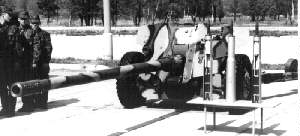
This is coolbert: In a previous blog I mentioned the German 88 mm gun. One of the most effective and significant weapons of World War Two [WW2]. Well, the Soviets did of course observe the effectiveness of this weapon and did during the war develop equivalent models to counter German tanks. The direct fire gun such as the 88 mm gun was perhaps the effective anti-tank weapon during WW2.
And for decades after the end of WW2, the Soviets continued to field battalions of such weapons, direct fire anti-tank guns, in their inventory. Long after the various armies of the western powers [western armies felt the anti-tank guided missile was the way to go] had determined this weapon, the anti-tank gun, to be obsolete, the Soviets felt the contrary, and continued to deploy the anti-tank direct fire gun in prodigious numbers.
Up until just recently, and maybe even now, as we speak, the Soviets, and subsequently the Russians, deployed in each of their Motorized Rifle Divisions [MRD] a battalion of anti-tank guns. This was the T-12 towed 100 mm anti-tank gun. Looked like a obsolete artillery piece with a long barrel and the crew shield [protection against small arms fire] in front. Each MRD, as mentioned, would have a battalion of these guns, totaling eighteen. This battalion was organized into three batteries of six guns each, the battalion being under the direct command of the division commander.
This battalion was under direct control of the division commander and would be used in two specific circumstances, and only at the behest of the division commander. If the MRD was on the defensive, this battalion would be put astride the avenue of approach into the divisional area that the divisional commander had determined to be the most favorable approach for the enemy to employ. And if the division was on the offensive, the battalion would be employed only when a breakthrough was accomplished. This firing batteries of the battalion would be employed to defend against an enemy counterattack the intention of which was to seal the breakthrough.
From this we can understand that the anti-tank battalion of the MRD was a special unit designed to be used in the most special of circumstances, and at the total command of the divisional commander.
Suvorov devotes and entire chapter to these guns and their employment by the Soviets. Suvorov writes: [The chapter is titled, "Why Are Anti-Tank Guns Not Self-Propelled].
"Anti-tank guns are used in two situations. In defense, when the enemy has broken through . . . and must be stopped at any price. And in the offensive, when one's own troops have broken through . . . and the enemy tries to cut off the spearhead at it's base . . . Towed guns are compelled, by their weight, to fight to the death . . . . Only one option is available to the crews - to die on the spot, as they prevent the enemy from crossing the line they are holding."
Nobody ever said service in the Russian military was easy.
coolbert.

0 Comments:
Post a Comment
Subscribe to Post Comments [Atom]
<< Home